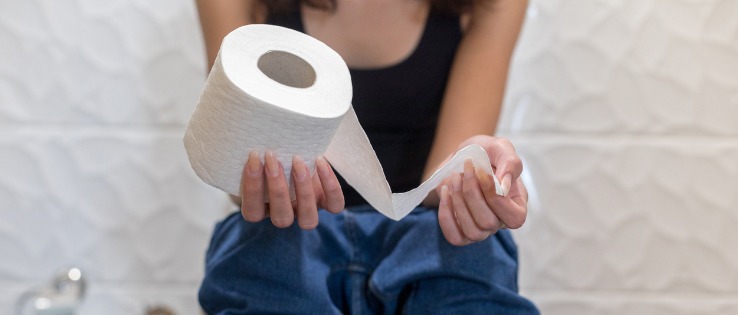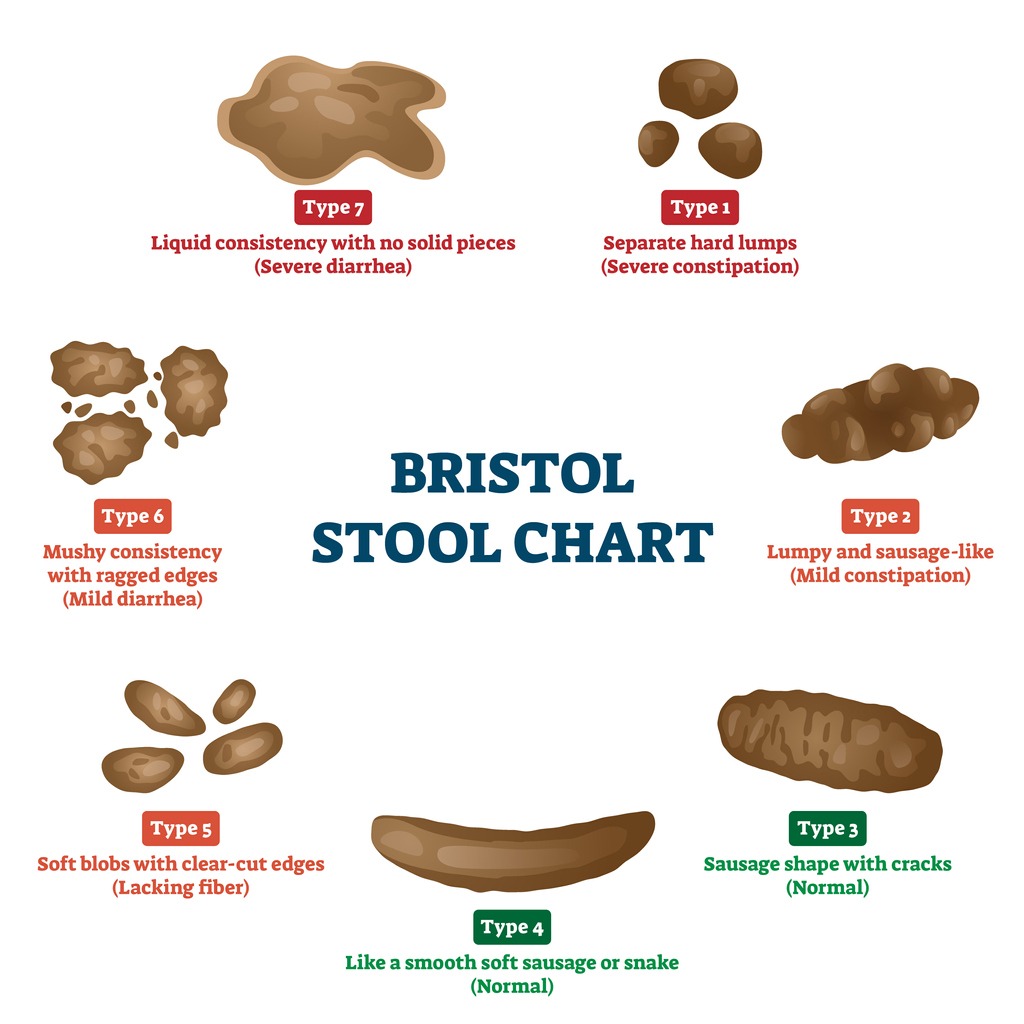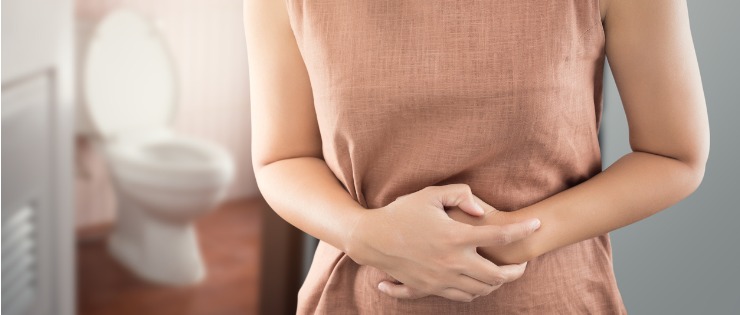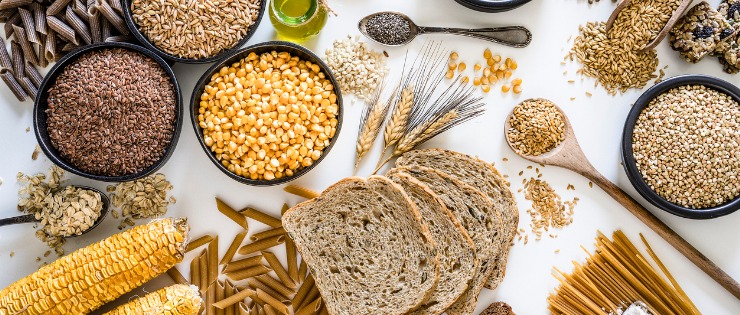
Unless you’re a young boy, poo isn’t something we think or talk about much!
But paying attention to your bowel movements is important. You could be missing vital clues about the state of your health. A quick look in the bowl after doing your business can tell you if your bowel movement is normal. But what should a healthy stool look like?
The Ideal Stool
Faeces are influenced by what we eat, drink, the medications we take and the lifestyle choices we make. It’s helpful to know the signs for a healthy bowel movement and one that’s not.
The Bristol Stool Chart
The Bristol Stool Chart is a medical aid used to classify faeces into seven groups. The stool chart can be used as a self-diagnosis test that helps patients discuss with their doctor what is for many an embarrassing topic.
The healthy stools chart includes illustrations and descriptions of faeces. Types 1 and 2 indicate constipation, types 3 and 4 are considered ideal stools and types 5, 6 and 7 indicate diarrhoea and urgency.
What Should Healthy Stools Look Like?
According to the University of Bristol the chart developed in 1997, reveals the ideal stool should look like a sausage with cracks on the surface (type 3) or like a sausage that’s smooth and soft (type 4).
As we all know, stools vary in colour, shape and size. Our diet, age, general health and lifestyle can all impact on what our poop looks like.

Colour
The normal colour for faeces is obviously poo brown! But there are times when faeces may be another colour. It may indicate that you have a problem or simply diet related. Black poo may be a sign of gastrointestinal bleeding, but the dark colour may be as simple as taking iron supplements or eating licorice.
Pale coloured stools may be a liver or gallbladder issue due to a lack of bile. A stool that’s green could be influenced by green coloured foods such as spinach or kale. Orange coloured stools are often caused by beta carotene rich foods such as carrots and sweet potatoes. A yellow hue can indicate the presence of too much fat in the diet.
Size & Shape of Stools
Healthy bowel movements are painless to pass, requiring little or no strain. Separate hard lumps (type 1) are hard to pass, but very soft stools (type 6) or watery stools (type 7) aren’t ideal either.
Floating stools aren’t considered healthy. They usually have a high fat content and may indicate that there’s a problem with malabsorption where the body doesn’t draw enough nutrients from the diet. It may also be related to gas, a change in diet or a minor infection. Ideally your poop should sink to the bottom of the toilet bowl.
Being Regular
Bowel movements are often referred to as being regular which many people assume refers to regularity of movements. However, ‘regular’ means faeces that are soft and well-formed that are passed easily.
Most people have a bowel movement once per day, but healthy people might go three times per day or the minimum three times per week.
If you’re unsure if you have healthy stools or how often you do a bowel movement, a bowel diary can help you keep track.
Abnormal Stools
Not sure if your bowel movements are in the normal, healthy range? You may need to seek medical attention from your GP if:
- You need to do a bowel movement more than three times per day
- You need to do a bowel movement less than three times per week
- You’re straining excessively while on the toilet
- Your faeces are coloured red, black, green, yellow, or white
- Your stools look fatty or greasy

Common Bowel Complaints
People experience a range of bowel problems that can impact on their quality of life. But many can be improved or cured with patience and lifestyle changes.
Incontinence
Leaking from the bowel can be linked to diarrhoea but not always. Also known as faecal incontinence, the leakage may be solid, liquid or gas. It can be caused by a variety of factors including childbirth, prolapse, diabetes, bowel disease, heavy lifting, poor pelvic floor muscles, or medications. Greasy or spicy foods, alcohol or caffeine can make the problem worse. Medications can make the condition better by slowing down the movement of bowel motions so they are firmer.
To make bowel movements less frequent and firmer, try eating white rice and bread, pasta, beef, chicken breast, potatoes, and cheese.

Constipation
Many people suffer from constipation where they strain while on the toilet and have hard or lumpy motions. They may feel like their bowel is blocked and have a bowel motion less than three times a week. Constipation can be caused by a lack of fluids or food, stress, poor diet with not enough fibre, and medications. Eating more fibrous foods such as vegetables especially cabbage, red capsicum, peas, beans, broccoli and corn, fruits including grapes and stone fruit can help. High fibre cereals and bread, spices, fibre supplements and fruit juice, drinking fluids and exercise can all help some people with constipation. Using a laxative and changing medications may be required to help relieve constipation.
Gas & Bloating
Bacteria live in the large bowel to help break down undigested food, and it’s this type of bacteria that can cause gas. It’s normal to break wind daily, but too much gas may be caused by eating foods that don’t agree with your digestive system such as foods from the cabbage family, dairy, eggs, artificial sweeteners, soft drink and bananas. Some people experience gas due to poor pelvic floor muscles.
Disease & Conditions Affecting the Bowel
Stool samples are used to screen for disease and illnesses. A stool culture is used for identifying bacteria or parasites that may be causing diarrhoea. The Helicobacter pylori bacteria may indicate a stomach ulcer or stomach cancer.
Bowel Cancer Screening
A faecal occult blood test (FOBT) is used to test people for blood in the faeces that may come from polyps or bowel cancer. The test can show up tiny traces of blood that aren’t visible to the naked eye. In Australia, most Australians aged between 50 and 74 are eligible for free FOBT tests as part of the National Bowel Cancer Screening Program. Early detection of bowel cancer leads to good survival rates.
Blood is detected in 1 in 14 tests, but not all positive tests will have bowel cancer. The blood can be caused by polyps, haemorrhoids, or inflammation. A colonoscopy is a more in-depth look at the bowel to determine the cause of a positive FOBT.
Health Conditions Impacting the Bowel
There are a range of conditions that affect the bowel. Some are minor while others have serious health and lifestyle implications.
Irritable bowel syndrome (IBS)
A common gastrointestinal problem that affects 11% of adults. It may cause abdominal pain, bloating and alternating between constipation and diarrhoea.
Crohn’s disease
An inflammatory bowel disease and autoimmune disorder that affects the colon and part of the small intestine.
Ulcerative colitis
An inflammatory bowel disorder that causes inflammation and ulcers in the digestive tract that can cause bleeding and discharge.
Celiac disease
An autoimmune disorder where gluten in the diet causes the immune system to attack the inner lining of the small intestines.
How to Improve Your Bowel Health
There are a few things you can do to improve your bowel and general health.
Pelvic Floor Muscle Training – The pelvic floor muscles support the bowel, bladder and uterus (in women). When the muscles are weakened, they can cause problems with bladder and bowel control. Exercises are often prescribed to strengthen pelvic floor muscles and reduce the impact of bowel control problems. Pelvic health physiotherapists are available to help with pelvic floor muscle training.
Increasing Dietary Fibre – Eating a fibre rich diet is important for ensuring faeces take up enough water to keep them bulky and soft. Insoluble fibre helps speed up bowel motions so they occur more often. You can increase your insoluble fibre by eating whole grain wheat, high fibre cereal and fibrous vegetables. Soluble fibre helps bind faeces together. Increase the amount of soluble fibre in your diet by eating oats, legumes, peeled fruits and vegetables.

Fibre supplements are also available for people who need more fibre than their diet provides. It’s important to take in plenty of fluids with supplements and start on the lowest suggested dose before slowly increasing the amount, if needed.
Resources
It can be hard to keep track of how often you go to the toilet and how well you feel. A bowel diary can be used to track your bowel movements over days or weeks and can give you more information when you’re speaking to your GP. The Bladder and Bowel Foundation has a diary you can download.
Continence nurses are available to assist with enquiries at the Continence Foundation of Australia.
Seeking Medical Attention
Remember paying attention to what’s in the toilet bowl is very important. If you have any concerns about your bowel health, you should speak to your local GP today.